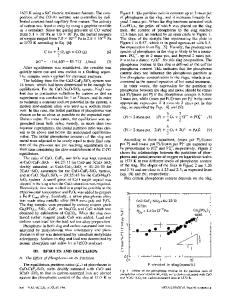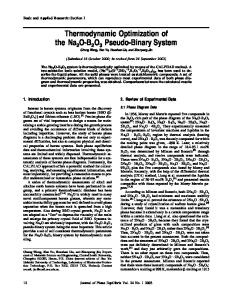Thermodynamic study of BaCuO 2 and BaCu 2 O 2
- PDF / 520,850 Bytes
- 5 Pages / 603.28 x 783.28 pts Page_size
- 66 Downloads / 315 Views
I.
INTRODUCTION
SINCE the discovery of the ceramic superconductor of YBazCu3065+x, a number of investigations have been made on the thermodynamic stabilities of the compounds in the Y-Ba-Cu-O systemJ ~,2,31Information on the Gibbs energy changes for syntheses of the compounds in the Ba-Cu-O system is important for evaluating the stability of the superconductor. The Gibbs energy change for synthesis of BaCuO2 has been presented by Zhanguo et al. tlj and Voronin et al. I2] and that of BaCu202 reported by Voronin et al. tzj Both groups employed electromotive force (emf) measurements using solid electrolytes of CaFz or BaF2. In this study, the Gibbs energy change of BaCuO2 for the reaction of BaCO3 + CuO = BaCuO2 + CO2 was investigated by thermogravimetry with CO2-O2-N2 gas mixtures. For the compound BaCu202, oxygen partial pressures at the equilibria for the reaction of BaCuO2 + CuO = BaCu202 + 1/2Oz were measured using galvanic cells employing yttria-stabilized zirconia solid electrolytes.
II.
THERMOGRAVIMETRIC STUDY OF BaCuOz
O2-N2 balance gas mixtures with a flow of 2 c m 3 / s up-
stream to the sample. The individual gas mixtures were supplied by premixed bombs. The compositions were confirmed by the vendor (Nippon Sanso Co., Tokyo) and also confirmed with calcium carbonate using the reaction of CaCO3 = CaO + CO2 using the thermogravimetric apparatus. The sample was heated in the apparatus to the experimental temperature with flowing CO2-O2-N2 gas mixture. For the reaction BaCO3 + CuO = BaCuO2 + CO2
[1]
the equilibrium temperature corresponding to the COz partial pressure in the individual gas mixture was investigated by the mass change of the sample held at an approximate temperature. That is, a weight loss of the sample means that the reaction is proceeding in the direction in which the BaCO3 decomposes, and the temperature is higher than that in equilibrium. Restoration of sample weight at a lower temperature means that the inverse reaction is occurring and the temperature is lower than that in equilibrium. The individual equilibrium temperatures were decided within an experimental error of -+5 K. Compounds in the samples were identified by X-ray powder diffraction analysis after removing them from the thermogravimetric apparatus.
A. Experimental Procedure
Samples were prepared by thoroughly mixing highquality powders of BaCO3 (99.9 mass pet) and CuO (99.99 mass pc0 in the molar ratio of 1 : 1, grinding well, and pressing them into pellets. The pellet was put in a platinum cell and placed in the thermogravimetric apparatus. The total weight of the sample used for the analysis was 0.6 to 1.0 g, and the experimental sensitivity of the thermogravimetric apparatus was 10 -4 g. The CO2 partial pressure in the reaction tube of the apparatus was controlled by one of 0.2 to 5 vol pct CO2-21 vol pet RYOKICHI SHIMPO, Research Associate, and YASUSHI NAKAMURA, Professor, are with the Faculty of Engineering, the University of Tokyo, Tokyo 113, Japan. Manuscript submitted August 2, 1993. METALLURGICALAND MATERIALS
Data Loading...











